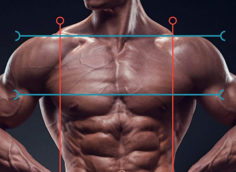The overhead squat (OHS) is one of the best multi-benefit movements. It's also one of the most hated movements by many people.
There's a baseline of flexibility required for a proper OHS and, for some reason, many just don't see the value in pursuing it.
If you can't perform the overhead squat comfortably, you've just failed a movement assessment. If you fail, it suggests you have a limitation somewhere in either your ankles, hips, thoracic spine, or shoulders. That means you'll need to cheat or compensate in other lifts.
Compensating can go on unnoticed for months or years before a problem arises, then suddenly your back, shoulder, or knee blows out and your lifting career is over.
Rather than avoiding a movement because it's difficult, prepare yourself for a challenge and master it. Not only will you get the flexibility and mobility benefits, but also shoulder stability, core strength, and leg strength.
- Shins Staying Vertical If your knees don't travel forwards as you squat, then your ankles probably lack dorsiflexion. Ideally, you shouldn't need to wear lifting shoes to do any squat.
- Can't Break Parallel If your knees can go forward, but you can't sit below parallel, it suggests your hips lack the mobility to sit in a squat while keeping your torso upright. In this case, your knees will try to help which can cause knee pain. Addressing your hips will make both your back squat and front squat better as well!
- Can't Hold the Bar Overhead If you can't comfortably hold the bar overhead in-line with your mid-foot with straight arms, or if you feel it travel forward when you start to squat, then your upper back flexibility needs work. Your shoulders may also lack stability. This also implies that any shoulder or overhead work you're doing isn't in the optimal position, which often causes shoulder impingement (a nipping or burning feeling).
Don't worry, you don't have to do a snatch to get the bar up. Here's how to set it up and do it.
- Un-rack the bar as you would for a back squat.
- Move your hands wider on the bar. Get them wherever they feel comfortable and strong overhead. If you have knurl marks on your barbells, try using them as your markers.
- Confidently dip down slightly and drive up through the floor, extending your hips violently. As the bar is travelling up, drop down again and catch it with your arms fully extended.
- Stand and make sure your feet are in the right position.
- Now begin to squat. Keep tension in your core and move slowly. It's easy to lose balance with overhead squats, so keep your movement deliberate and stay aware of the weight distribution in your feet.
- When you've finished the rep, control the barbell back behind your head onto your shoulders and dip as it lands. Move with the barbell to soften the impact.
As you get stronger and the bar gets heavier, there will come a point where you should just drop it to the ground or into a front rack position. Trying to drop a heavy bar behind your head onto your shoulders can be very challenging.
If your gym doesn't allow you to drop bars, then you can stay at lighter weights for higher rep schemes. This will help your endurance, shoulder stability, and core strength.
If you want to go heavy, your first goal should be a hitting your bodyweight for a 1RM. Then you can aim to increase that to a 3RM, 5RM, even 10RM. After that, you can push toward 1.5x bodyweight for a 1RM, but you'll need to start looking after your wrists for these kinds of weights.
Remember, don't rush. We're using this as a mobility and stability builder as well as pure strength, so cutting your depth short or "only just" getting reps isn't the goal.
You won't be able to lift as heavy with your OHS as you can with a normal back squat, but you can get the benefits just by throwing it in as a quick 3x3 squat warm-up. It hits everything while maintaining your mobility.
Honestly, once you get good at it, you'll love it. I mean, it's a leg day that also challenges your upper back and arms! Overhead squats are definitely worth the time investment.




